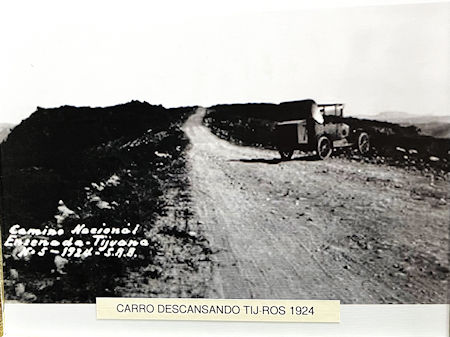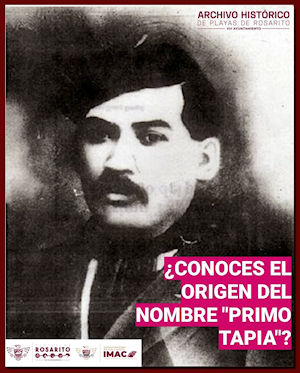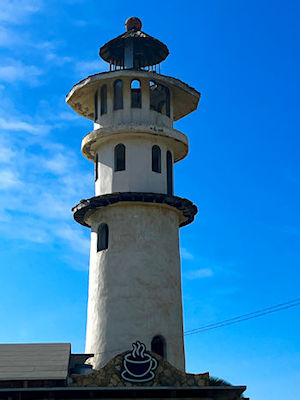 |  |

Most travelers from the United States drive right past Primo Tapia heading on to Ensenada or Baja Sur. Should something come up in the 65 miles between Rosarito and Ensenada, Primo Tapia has everything the traveler might need with a few surprises. Primo Tapia is the only place between the two cities with an ATM, car repair and even medical assistance with ambulance service. Let’s take a little trip into history to learn what was going on here centuries ago.
History
The whole northern area was actually a thriving community of different Indian tribes. The Kumiai, Kikapu, Papago, and the Cocopah once lived in this vast land that belonged to no one. There were no borders and people were free to roam about. There was everything needed for a good life as hunter gatherers with plenty of fresh water, lush vegetation and an abundance of animal and sea life.
Just east of town there is a community called Descanso, a resting place. The Kumiai lived in this whole area going back 10,000 years. Burial grounds can be found along this coastline all the way to Bajamar. Much later in Kumiai history the Dominican missionary Tomás de Ahumada founded the Mission El Descanso in 1810. The ruins of this mission are in El Descanso Valley. The missionaries found that this area had a mild, humid climate and fertile land. As the natives before them knew, the natural plants were good for eating and coastal shrubs for building, and the padres this learned too. Nature provided and life was sustainable.

South of town at the edge of the Pacific are the historic Los Arenales sand dunes created by the prevailing coastal wind-stress. Anyone living nearby knows when the wind kicks up coming off the ocean the sandstorms with blowing grit can be an issue. It takes 7,000 years to create a “young” sand dune and the ones here are thought to be somewhere around 20,000 years old. Developers today are attempting to defy mother nature and are leveling the lovely dunes to build homes with an ocean view. One fragile portion of Los Arenales remains as a sports area for ATVs and sand boarding.
In 1924 the first major dirt road from Tijuana to Ensenada was being used. This of course began to link the ranchito communities. Primo Tapia and was officially named in 1956. The name honors a hero of the people Primo Tapia de la Cruz. Primo Tapia was born in 1885. He was killed in the Mexican agrarian movement trying to redistribute land equitably among the population. This reform aimed to restore land to legal owners, reduce poverty and inequality, and secure political stability.
Today, Take a Look Around
Coming from the north, take the Cantamar exit. At the stop sign you will make a left into Primo Tapia. To the right is the Cantamar community, founded by Alejandro Borja. Alejandro brought his young bride, Maria, to this area. She was enchanted by the sounds of the ocean and named her new home Cantamar, Ocean’s Song. In 1964 Borja’s fanciful mind created the lighthouse with full intention to have it operational. However, it was not allowed to shine its light because the Mexican Navy said the property was not aligned correctly as a Navigational aid. Sadly today, it is going into ruin.

Turning left into this busy little town there is still a bit of nostalgia as it has not lost the flavor of days gone by. You will still see cowboys riding through town. It is wise to know that rules of the road in town are more like a suggestion, so, you might see all kinds of creative driving. The streets are lined with vendors selling their wares and farmers with their trucks loaded with melons, corn and other farm produce. There are food stands galore and all of them surpass the quality of any fast-food chain because everything is handmade fresh from the local farms. A real find on weekends sheltered under a blue shade cloth is a Señora selling shrimp from the Gulf of California. The jumbo shrimp sell for 300 pesos a kilo that would be approximately $7.50 a pound.
Primo Tapia even has its own mini Walmart-like store, El Jefe. It's fun just to see how much a little shop can hold inside. Every inch of space is used, including the ceiling. There is all manner of household goods, grocery items, and spirits including a few fine wines from the Guadalupe Valley. You will see American bands names as the owner drives to the U.S. weekly to take care of her American neighbors. They have an ATM for pesos. It is certain you will find what you need, but maybe not everything you want.
Just next door is Similaris, with a jolly mustached pharmacist pointing the way. They are known for lower priced medical aids and they do have a doctor on site who can write prescriptions. The fee is $50 Pesos, about U.S. $2.50. Across the street is Roma, another pharmacy, also with a doctor in attendance. After you leave there keep an eye out for the tire shop. They are efficient and can change your tire in a blink of an eye for mere pesos.

Further on, beyond the stoplight and before the bridge, you can make a right down a slight grade and head to the ocean. You might note the whimsical murals painted on the walls by young muralist fantasying jungle life. There is a tiny public area where you can picnic. Or later in the day order a wood-fired pizza from Catrina’s, a tiny restaurant that hangs off the edge of the cliff with miles of ocean view from north to south.
The town ends just before the bridge. Turn right and down the hill to Jose Cruz Navarro Community Park. It is the hub of the whole town and on weekends there are blocks and blocks of vendors and food booths. You never know what you might discover.
A Short Guide
First Block: The police and fire station, El Jefe store with ATM, Similaris and Roma pharmacies
Second Block: Tire repair, lab for blood work, and fun food stands
Third Block: Long block to stoplight. Casa de cambio, PC repairman and cell phone repair.
Just after the stoplight, which may or may not be functioning, turn right down a steep hill to the little park with an ocean overview and Catrina’s wood-fired pizza.
Fourth Block: The town ends at the Bridge – turning right to the community park and weekend flea market.
A few minutes south on the free road is the Cruz Roja EMT office and ambulance service. The EMTs can handle your emergencies. They can transport to a local hospital to be stabilized and on to the border to be transferred into the U.S. You can call 911 or drive directly to the office. The main doors look like the office is shut down. Go to the door on the far right.
Well, there you have it. Make a point to give this little town a try and then take the scenic road south past the sand dunes to La Fonda. From there you can travel the free road all the way to the wine country, or catch the toll road to Ensenada.


Great insurance for your motor trip to Mexico.

fast replies and great price!

Easy to buy Mexico car insurance from and good service